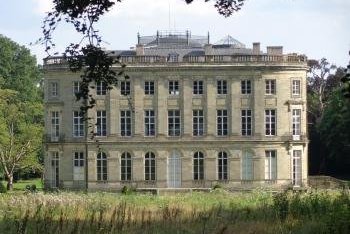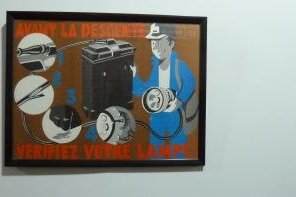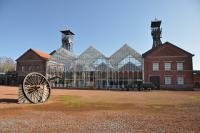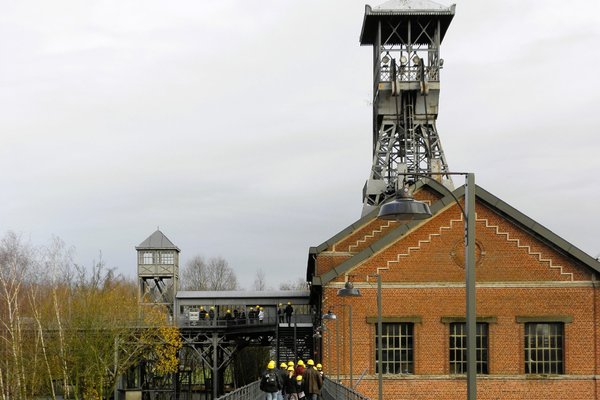France
Nord-Pas de Calais Mining Basin
The Nord-Pas de Calais Mining Basin is a mining and industrial cultural landscape along a 120km long coal seam in the far north of France.
It represents the large-scale coal mining of the 19th and 20th centuries, and its associated social developments such as the occurrence of major disasters, international migration and worker unionism. Preserved elements include pits, slag heaps, railway stations and mining villages with schools, religious and community buildings.
Community Perspective: Don’t expect anything as grandiose as the Ruhrgebiet in Germany. The Historic Mining Center in Lewarde (location #22, Fosse Delloye) is a good place to start. Nan and Claire have reported on some locations (there are 109 in total!) in Lens and Liberville.
Site Info
Official Information
- Full Name
- Nord-Pas de Calais Mining Basin (ID: 1360)
- Country
- France
- Status
-
Inscribed 2012
Site history
History of Nord-Pas de Calais Mining Basin
- 2012: Inscribed
- Inscribed
- Type
- Cultural
- Criteria
- ii
- iv
- vi
Links
- UNESCO
- whc.unesco.org
- Official
-
- bassinminier-patrimoinemondial.org — Le Bassin Minier
- Related
-
- chm-lewarde.com — Mining museum in Lewarde
All Links
UNESCO.org
- whc.unesco.org — whc.unesco.org/
Official Website
- bassinminier-patrimoinemondial.org — Le Bassin Minier
Related Resources
- chm-lewarde.com — Mining museum in Lewarde
News Article
- June 8, 2017 lavoixdunord.fr — Bruay-La-Buissière art déco hôtel de ville destroyed by fire
Community Information
- Community Category
- Secular structure: Mines
- Cultural Landscape: Continuing
Travel Information
Recent Connections
-
Perfect Inscriptions
2012 -
Company town
Cité des ÉlectriciensSee fr.wikipedia.o…
-
Wooden architecture
Église Sainte-Cécile de Raismes and its…
Connections of Nord-Pas de Calais Mining Basin
- Individual People
- Geography
-
-
Scheldt
Several components lie in the vicinity of the Scheldt, e.g. secteur d'Amaury, paysage et ensemble miniers de Sabatier & Thivencelles, Château Dampierre (Valenciennes)
-
- Trivia
-
-
Serial sites with the greatest number of locations
108 -
Tour de France
2022 Stage 5 Lille > Arenberg Porte du Hainaut: Starts and Ends in different WHS!! It winds through the whole area but certainly enters the core zone at Cité Barrois, and the stage ends in the core zone at Paysage et ensemble miniers de Wallers-Arenberg et Paysage et ensemble Miniers d'Haveluy -
Fatal Accidents or 'disasters'
Courrières disaster (1906, almost 1,100 deaths) (AB ev)
-
- Ecology
-
-
Salamanders
Northern crested newt in the lac d'AmaurySee fr.wikipedia.org
-
- Architecture
-
-
Wooden architecture
Église Sainte-Cécile de Raismes and its rectorySee fr.wikipedia.org
-
Brick architecture
-
Art Deco
Gare de LensSee fr.wikipedia.org
-
Reinforced Concrete
Headframe of the Fosse DutempleSee fr.wikipedia.org
-
Neoclassical architecture
Château de l'HermitageSee fr.wikipedia.org
-
Garden City Movement
For example, in France, the first garden city, which was built in the Nord-Pas-de-Calais coal mining basin from 1904, offered up a new way of looking at housing for workers (see link)See www.iau-idf.fr
-
Modern Urban Planning
Criterion (iv): The living and evolving mining landscapes of the Nord-Pas de Calais Basin provide an eminent example of the large-scale development of coal mining in the 19th and 20th centuries, by large industrial companies and their considerable workforce. This is a space structured by urban planning, specific industrial structures and the physical vestiges of coal extraction (slag heaps and subsidence).
-
- Damaged
-
-
Cultural sites damaged by fire since inscription
Bruay-La-Buissière art deco hotel-de- ville (8 June 2017) -
Damaged in World War I
During the 1914-1918 War, the Basin was cut in two by the Front. The occupied eastern section was flooded when the invasion occurred; it suffered lasting damage (AB ev)
-
- World Heritage Process
-
-
Perfect Inscriptions
2012 -
Industrial Landscapes
-
Incorrect UNESCO 'Number of locations'
Component "Paysage et ensemble miniers de la Bleuse Borne" of the Nord-Pas de Calais Mining Basin WHS is missing from the UNESCO website. It should be component #10, between "Cité du Rivage ancienne" and "Château Dampierre." It actually disappeared between pages 7 and 8 of the nomination dossier!
-
- Religion and Belief
-
-
Protestantism
1360-071 Temple protestantSee whc.unesco.org
-
- Human Activity
-
-
Company town
Cité des ÉlectriciensSee fr.wikipedia.org
-
Locations for playing sport
Stade Parc in Bruay-La-Buissière -
Coal Mining
-
- Constructions
-
-
Obelisk
Monument aux morts de la compagnie des mines de Lens, situé à l'intersection de la route de Béthune et de l'avenue de la fosse 12" in LensSee www.google.com
-
Railways
3 railway stations for heavy transport were built (AB ev) -
Hospitals
numerous hospitals, dispensaries, pharmacies, maternity clinics, milk depots, etc., for the miners and their families (AB ev)
-
- WHS on Other Lists
-
-
European Destinations of excellence
The Mining History Centre (2017)
-
- Timeline
-
-
Built in the 18th century
coal extraction from the 18th to the 20th centuries (AB ev)
-
- WHS Hotspots
- Literature & Film
-
-
Literature
Criterion (vi): justified by the State Party on the grounds that the Mining Basin is closely associated with the description of workers' conditions in Continental Europe, notably starting from a novel by Émile Zola, Germinal (1885) [Unesco did not fully copy this, but the criterion vi was granted]
-
News
- lavoixdunord.fr 06/08/2017
- Bruay-La-Buissière art déco hôtel…
Recent Visitors
Visitors of Nord-Pas de Calais Mining Basin
- Adrian
- Adrian Turtschi
- Aitia
- Alexander Barabanov
- Alexander Lehmann
- alicemears
- A. Mehmet Haksever
- Ammon Watkins
- Ana Lozano
- Antonio J.
- Argo
- Astraftis
- Atila Ege
- Bauchat
- BaziFettehenne
- Bin
- Bram de Bruin
- Brendan Carroll
- Can SARICA
- Cezar Grozavu
- chenboada
- christof
- Christoph
- Christravelblog
- Claire Bradshaw
- Clyde
- Csaba Nováczky
- Damientournay
- dana144
- Daniel Chazad
- del
- Dimitar Krastev
- Dirk-pieter
- Dorejd
- Dwight Zehuan Xiao
- Echwel
- Elia Vettorato
- Els Slots
- Enid MC
- Erik Jelinek
- Errol Neo
- Eva Kisgyorgy
- fabi-ddorf
- Fan Yibo
- Femke Roos
- Francky D'Hoop
- Frederik Dawson
- GeorgeIng61
- giloudepuertorico
- Hubert
- Iain Jackson
- Ian Cade
- ih0000
- Ingemar Eriksson
- Ivan Rucek
- Jakob F.
- James Bowyer
- Janina Lehmann
- janis
- Jan-Willem
- Jarek Pokrzywnicki
- Jasam
- Jawnbeary
- Jay T
- Jean Lecaillon
- Jeanne OGrady
- Jeffrey Chai
- Jesse S 2010
- Jezza
- Joel on the Road
- Jonas Kremer
- jonathanfr
- Joyce van Soest
- Jurre
- Just_hatched
- KarenBMoore
- Kbecq
- Kevin247
- Knut
- Kurt Lauer
- Laetitia Yin
- Lara Adler
- Lisu Marian
- Loic Pedras
- Luis Filipe Gaspar
- Maciej Gil
- Maciej Gowin
- marcel staron
- marc Rouserez
- Martina Rúčková
- MaxHeAnouBen
- MaYumin
- MH
- Michael Turtle
- Mihai Dascalu
- Mikko
- Mohboh
- nan
- Nihal Ege
- Olli-Pekka Turunen
- PabloNorte
- Patrik
- Paul Schofield
- Peter Lööv
- Philipp Leu
- Philipp Peterer
- Pieter Dijkshoorn
- Priyaranjan Mohapatra
- Rafał Kałczuga
- Ralf Regele
- Randi Thomsen
- Rick Ohm
- Roel Sterken
- Roger Ourset
- Roman Bruehwiler
- Rudegirl
- Samy G
- Sandra!
- scubarrie
- Sergio Arjona
- Shandos Cleaver
- Simonh
- Solivagant
- Stanislaw Warwas
- stephanvermeulen
- Stijn
- Svein Elias
- Szucs Tamas
- Taotao Chen
- Tarquinio_Superbo
- Tatiana Nikulnikova
- Thomas Buechler
- Thomas Harold Watson
- Thomas van der Walt
- tommasorossotti
- tony0001
- triath
- Tsunami
- Vanessa Buechler
- Vincent Cheung
- WILLIAM RICH
- Wojciech Fedoruk
- Xander Huang
- YaroMir
- Yongcheng Liu
- Zhenjun Liu
- Zoë Sheng
- Zos M
Community Reviews
Show full reviews
As others have already said, this listing covers a large area, so choosing how to visit is a bit of a challenge. I agree with the view that this would have been a stronger listing had a smaller number of sites, with a clear link to the criteria, been chosen, as per the other serial listings such as wooden churches etc.
In the end we chose the area around Lens as it seemed to offer a variety of different types of site which are included in the listing, such as the company town, old pit heads and workings, slag heaps etc. I will admit to being disappointed though, which is a shame as I generally enjoy industrial sites.
Initially we walked from the train station around the town itself looking at the various memorials, housing areas and company buildings included in the listing. The walk was not that interesting though and at no time did I get a feel for Lens being a 'company town' which is what I had been expecting. There was no cohesion between the sites we looked at, and due to the lack of information boards, no way of interpreting what we saw in the context of the 'mining town'.
After this we walked over to the Louvre Lens, something the town seems (rightly) very proud of. The new building for the gallery is built on top of an old pit, and the surroundings here do include a few boards explaining the landscape …
Keep reading 0 commentsJakob F.
Nord-Pas de Calais Mining Basin by Jakob Frenzel
Nord-Pas de Calais Mining Basin (Inscribed)

July 2018 - first day in France we passed through the Nord-Pas de Calais Bassin- another mining area, great.
First we wanted to visit more sites, but the first glimbse that we got in Lens was enough. The area seems to be quite poor for French standard. The WHS consists of diifernet kind of sites. Piles of coal, mines, settlements for workers, railway stations. An ensemble of many different things. Compared to the Belgian sites its very widespread, lets see how Erzgebirge will be doing. I think it is way more influential than this site. But maybe next time I should visit some more componenets.
Keep reading 0 comments
The slag heaps very visible when moving around in the Lens area gives a remaining memory. About 250 och around 350 made ones are left. There are som many aspects of this area as we can find belfries and WW1 memories everywhere.
We come in contact with this WHS when visiting Louvre-Lens. This monumental new museum is built on the site of an old coal-mine. Some of it`s history shown in museum. Next to museum site is a complex of houses intended for miners who are inscribed in the WHS area and it is easy to stroll around in that area when having reached Louvre-Lens.
Also the monumental destroying of the area in WW1 gives a backdrop for the need for Germany to pay a lot for that destruction in later agreements. Now is 100 years since WW1 ended and there are not many traces left of the war except the many monuments and graves that are kind of everywhere. Farmland is fixed but if you go up to Canadian memorial place Wimy outside of Lens, we can see fields that are left as they were 1918 and just natural erosion has tried to level out the ground in the battlezone. Perhaps this is not in the WHS but it is very much in this area and we really can't move much in this WHS before seeing some WW1 memorial. I generally agree with the review of NAN 2017, also why the Belgian mines are not in the …
Keep reading 0 comments
Coming in from Arras by train I immediately ticked off this site when I stepped off the train in Lens; the Gare de Lens is part of the inscription. From the station I headed into town and ticked of all locations in Lens. This included a World War 1 memorial for the fallen citizens, a unionist memorial, the historic union building, a worker housing district and the former headquarters of the mining company. Unfortunately, the signposting is lacking, so I found myself repeatedly wondering if I had found the site or not.
After Lens I headed to Liberville to get a bit more of the industrial feeling of the site. From the train window several furnaces and mines could be seen, some of them part of the inscription.
In Liberville I found myself lost again, wandering around a simple neighborhood and looking for the site and its OUV. I guess, the neighborhood itself was the site. The area wasn’t really touristy and the one furnace in town closed, so I decided to call it a day and head on to Lille by train.
Looking back, I found Lens rather interesting and would recommend it as a good place to explore the site. There are no mines and furnaces in Lens, though. Instead this is where the workers lived. I guess they took the same train line I did to get to the work in the mines every day.
The former wealth on display is impressive. …
Keep reading 0 comments
I visited Chateau Hermitage, which used to be the manager's house of the mining company.
This Chateau is located inside the huge Park Hermitage, which is designed for hiking and biking today, and it was quite a nice hike in the afternoon I visited.
Keep reading 0 comments
Another day, another North Western European mining landscape to visit. And like the others here we headed to the mining museum at Lewarde.
It was quite an enjoyable visit, helped by the wonderful late winter weather. The guided tour in French was complimented by an easy to use audio guide in other languages. The initial walk through the above ground processing plants was the most interesting. Then there was a walk through a mock mine housed in above ground tunnels. It was an interesting way of recreating the mining experience, of course it takes away many of the most disconcerting aspects of working underground, but then I guess almost all tours of European mines will do that. It did mean that the different mining technologies could be displayed next to each other to allow for comparison, and showed how technological advances improved life and safety in the mine. There was also a brief section on immigration from North Africa, which grew to staff the masses of mines in the area.
The guided tour lasted a little longer than we planned, as such on finishing we had to rush off in a dash to catch our ferry. The rest of the landscape, scarred and sculpted through centuries of heavy industrial work, flew past quickly, but human activity is really evident. The towns seemed like many once great industrial areas that now seem sleepy and down at heel, having lost the central focus of their existence, hopefully some international recognition can bring …
Keep reading 0 comments
I visited this WHS in February 2014 on a cold sunny day. I decided to "visit" a number of sites included in the buffer zone and marked on the official UNESCO website. After a few attempts that yielded nothing more interesting than a couple of mounds of earth, a few desolate brick houses, a small church near Aniche and a closed-down railway, I decided to drive straight to France's largest mining museum, the Nord-Pas de Calais Mining History Centre in Lewarde, which is actually a former coal mining plant where various trains, railways and rusty machinery can be seen. The visitor centre is quite interesting to visit although not as grandiose as the Ruhrgebiet in Germany. The information available near the 18 viewpoints across the mining site is only in French so an audioguide is necessary to be able to appreciate the history behind this place. Certain places are only accessible with a guided tour that takes around 1 hour (you have to wear a bright yellow helmet inside too!). The highlight of my trip was the hanging clothes room where I could really appreciate how tough life must have been for coal miners. The museum is very expensive (14 euro or 12.50 euro) but at least there are all the facilities you could think of such as a restaurant, a cafeteria, toilets, a souvenir shop and also a pic-nic area outside. I would judge this WHS as France's least interesting. To be honest, I very much preferred other industrial …
Keep reading 0 comments
Miners' Centre, Lewarde, France -
As an Australian coal mining historian I attended the 2010 Lewarde Colloquium. This centre is an absolute marvel in terms of its presentation of the life and hard times of coal miners and their communities. It is a living link with Zola's Germinal. It is well-managed, welcoming and not to be missed.
For professional mining historians, students or family visitors, Lewarde is a treasure and a credit to all who continue to remind us of the debt the present owes to the past.
Alan Murray, Australia.
Keep reading 0 comments
This is the French nomination for 2012: a stretch of 120km in the North of the country comprising various mining sites. When I was sent to attend a course at the Capgemini University just north of Paris, I thought it was a fine opportunity to take this possible new WHS on my way back home.
I went to visit the Historic Mining Center in Lewarde, the main museum in the area. It is surprising how little in the surroundings reminds us of the mining era. Nothing like the raw industrial beauty of the Ruhrgebiet just over the border in Germany. It just looks like a quiet rural setting. Coal was mined here from the 18th century till the 1970s. The harsh working and living conditions were immortalized in Emile Zola's Germinal, which happens to be one of my favourite 19th-century novels.
The mining center is pretty large and modern, though not yet well-equipped to receive visitors who do not speak French. Also, at the exhibitions, I did not find anything that I had not seen before at similar sites around the world. It indeed is a big question what the OUV of this site is, and the short description on the UNESCO website does not help to clarify it. What I've learned while researching it on the internet is that this probably will be a serial nomination with single monuments scattered along the whole 1200 km2. It is marketed as an "evolved cultural landscape", as the mono-industry of coal mining …
Keep reading 0 comments

